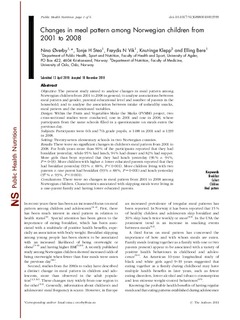| dc.contributor.author | Øverby, Nina Cecilie | |
| dc.contributor.author | Stea, Tonje H. | |
| dc.contributor.author | Vik, Frøydis N. | |
| dc.contributor.author | Klepp, Knut-Inge | |
| dc.contributor.author | Bere, Elling | |
| dc.date.accessioned | 2011-11-08T11:15:39Z | |
| dc.date.available | 2011-11-08T11:15:39Z | |
| dc.date.issued | 2011 | |
| dc.identifier.citation | Øverby, N., Stea, T. H., Vik, F. N., Klepp, K.-I., & Bere, E. (2011). Changes in meal pattern among Norwegian children from 2001 to 2008. Public Health Nutrition, 14(9), 1549-1554. | no_NO |
| dc.identifier.issn | 1368-9800 | |
| dc.identifier.uri | http://hdl.handle.net/11250/139003 | |
| dc.description.abstract | Objective: The present study aimed to analyse changes in meal pattern among Norwegian children from 2001 to 2008 in general; to analyse associations between meal pattern and gender, parental educational level and number of parents in the household; and to analyse the association between intake of unhealthy snacks, meal pattern and the mentioned variables.
Design: Within the Fruits and Vegetables Make the Marks (FVMM) project, two cross-sectional studies were conducted, one in 2001 and one in 2008, where participants from the same schools filled in a questionnaire on meals eaten the previous day.
Subjects: Participants were 6th and 7th grade pupils, n 1488 in 2001 and n 1339 in 2008.
Setting: Twenty-seven elementary schools in two Norwegian counties.
Results: There were no significant changes in children's meal pattern from 2001 to 2008. For both years more than 90 % of the participants reported that they had breakfast yesterday, while 95 % had lunch, 94 % had dinner and 82 % had supper. More girls than boys reported that they had lunch yesterday (96 % v. 94 %, P = 0·03). More children with higher v. lower educated parents reported that they had breakfast yesterday (93 % v. 88 %, P < 0·001). More children living with two parents v. one parent had breakfast (93 % v. 88 %, P = 0·001) and lunch yesterday (97 % v. 93 %, P < 0·001).
Conclusions: There were no changes in meal pattern from 2001 to 2008 among Norwegian children. Characteristics associated with skipping meals were living in a one-parent family and having lower educated parents. | no_NO |
| dc.language.iso | eng | no_NO |
| dc.publisher | Cambridge University Press | no_NO |
| dc.title | Changes in meal pattern among Norwegian children from 2001 to 2008 | no_NO |
| dc.type | Journal article | no_NO |
| dc.type | Peer reviewed | no_NO |
| dc.rights.holder | © 2011 The Author(s) | |
| dc.subject.nsi | VDP::Medical disciplines: 700::Health sciences: 800 | no_NO |
| dc.source.pagenumber | 1549-1554 | no_NO |
| dc.source.volume | 14 | |
| dc.source.journal | Public Health Nutrition | no_NO |
| dc.source.issue | 9 | |
| dc.identifier.doi | https://doi.org/10.1017/S1368980010003599 | |
